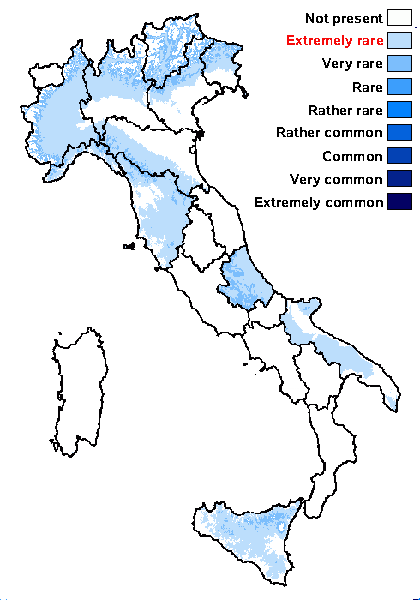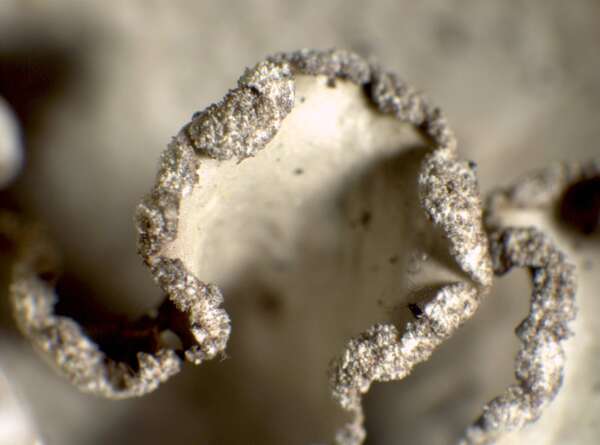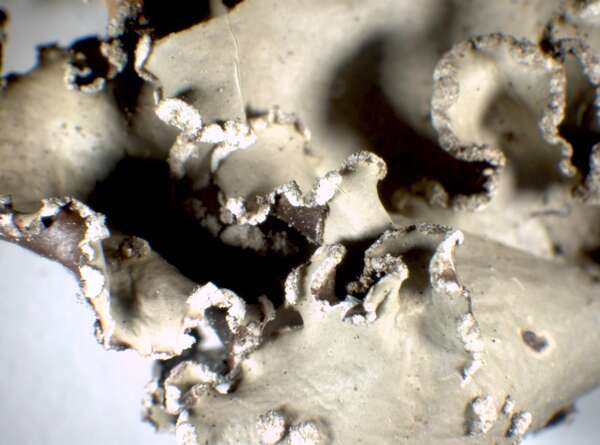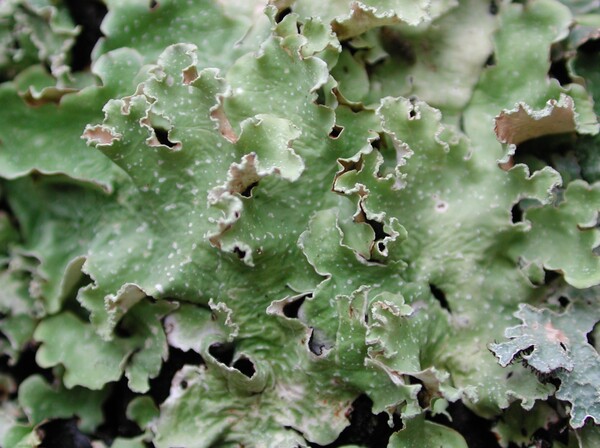Cetrelia olivetorum (Nyl.) W.L. Culb. & C.F. Culb.
Contr. U.S. Nat. Herb., 34: 515, 1968. Basionym: Parmelia olivetorum Nyl. - Not. Sällsk. Fauna Fl. Fenn. Förh., n. ser., 5: 180, 1866.
Synonyms: Parmelia cetrarioides var. rubescens (Th. Fr.) Du Rietz; Parmelia olivaria f. subvenosa Gyeln.; Parmelia rubescens (Th. Fr.) Vain.; Pseudoparmelia aradensis Gyeln.
Distribution: N - Frl (Nimis 1982, Gheza & al. 2025), Ven (Gheza & al. 2025), TAA (Gheza & al. 2025), Lomb (Gheza & al. 2025), Emil (Gheza & al. 2025), Lig (Gheza & al. 2025).
Description: Thallus foliose, heteromerous, dorsiventral, broad-lobed, loosely attached, forming wide-spreading, usually orbicular 6-20(-40) cm wide rosettes. Lobes broad and rotund, (0.5-)1-1.5(-2) cm wide, with raised, wavy margins, greenish grey (sometimes tinged brown), with punctiform pseudocyphellae on upper surface, which are rather small and usually not raised, often concentrated in the submarginal parts of lobes; pseudocyphellae on the lower surface not developed, or appearing as very small white dots. Soralia primarily marginal, elongated, usually smooth, with fine to rather coarse soredia. Lower surface black, rather regularly ridged, with scattered, simple, black rhizines and a brown, rhizine-free zone along the margin. Upper and lower cortices prosoplectenchymatous, the upper one with a non-pored epicortex, of densely agglutinated hyphae with tiny lumina; medulla white, with isolichenan, I-. Apothecia very rare, lecanorine. Asci 8-spored, Lecanora-type. Ascospores 1-celled, hyaline, ellipsoid, 12-15 x 7-10 µm. Pycnidia unknown. Photobiont chlorococcoid. Spot tests: cortex K+ (weakly) yellow, C-, KC-, P-; medulla and soralia K+ yellow, C+ strongly blood-red, KC+ reddish, P-, UV-. Chemistry: cortex with atranorin and chloroatranorin (in lower amounts than in soralia); soralia (and medulla) with atranorin, olivetoric acid, anziaic acid, and 4-O-demethylmicrophyllinic acid, sometimes with a fatty acid.Note: a species with the olivetoric acid syndrome, found on bark of broad-leaved trees and on epiphytic, more rarely silicicolous mosses in humid, old forests, locally still locally abundant in montane Abies-Fagus forests, especially in the Eastern Alps. Here the species, which is certainly widespread in Italy, is still treated in a broad sense: several records before 2007 could refer to the other species of the complex. The species was included in the Italian red list of epiphytic lichens as “Near-threatened” (Nascimbene & al. 2013c). Only records confirmed by Gheza & al. (2025) are reported.
Growth form: Foliose, broad lobed
Substrata: bark
Photobiont: green algae other than Trentepohlia
Reproductive strategy: mainly asexual, by soredia, or soredia-like structures (e.g. blastidia)
Most common in areas with a humid-warm climate (e.g. most of Tyrrenian Italy)
Commonnes-rarity: (info)
Alpine belt: absent
Subalpine belt: absent
Oromediterranean belt: absent
Montane belt: very rare
Submediterranean belt: extremely rare
Padanian area: absent
Humid submediterranean belt: extremely rare
Humid mediterranean belt: absent
Dry mediterranean belt: absent

Predictive model
Herbarium samples


P.L. Nimis; Owner: Department of Life Sciences, University of Trieste
Herbarium: TSB (29405)
2001/12/09
soralia


P.L. Nimis; Owner: Department of Life Sciences, University of Trieste
Herbarium: TSB (29405)
2001/12/09
Growth form: Foliose, broad lobed
Substrata: bark
Photobiont: green algae other than Trentepohlia
Reproductive strategy: mainly asexual, by soredia, or soredia-like structures (e.g. blastidia)
Most common in areas with a humid-warm climate (e.g. most of Tyrrenian Italy)
Commonnes-rarity: (info)
Alpine belt: absent
Subalpine belt: absent
Oromediterranean belt: absent
Montane belt: very rare
Submediterranean belt: extremely rare
Padanian area: absent
Humid submediterranean belt: extremely rare
Humid mediterranean belt: absent
Dry mediterranean belt: absent

Predictive model
| Herbarium samples |


P.L. Nimis; Owner: Department of Life Sciences, University of Trieste
Herbarium: TSB (29405)
2001/12/09
soralia


 INDEX FUNGORUM
INDEX FUNGORUM
 GBIF
GBIF
 DOLICHENS
DOLICHENS



